Please find our most recent market review below. We hope these perspectives are valuable to you.
– The AdvicePeriod Team
The Economy Remains Resilient
The U.S. economy continued to grow through the first five months of the year. Bonds moved lower as economic numbers came in a bit better than expected. International stocks lagged U.S. equities as the mega-cap tech names drove domestic outperformance. While investors continue to anticipate an end to the Federal Reserve’s rate-hiking cycle, the possibility of one more increase in June remains on the table.
Key Observations
- The stock market was up slightly in May and is up nearly 10% year to date.
- Small-cap and mid-cap stocks continue to underperform as the large tech companies have been driving outperformance.
- Bonds ended the month moderately lower but are still up 2.5% for the year.
- International developed and emerging markets fell in May but are still positive year to date.
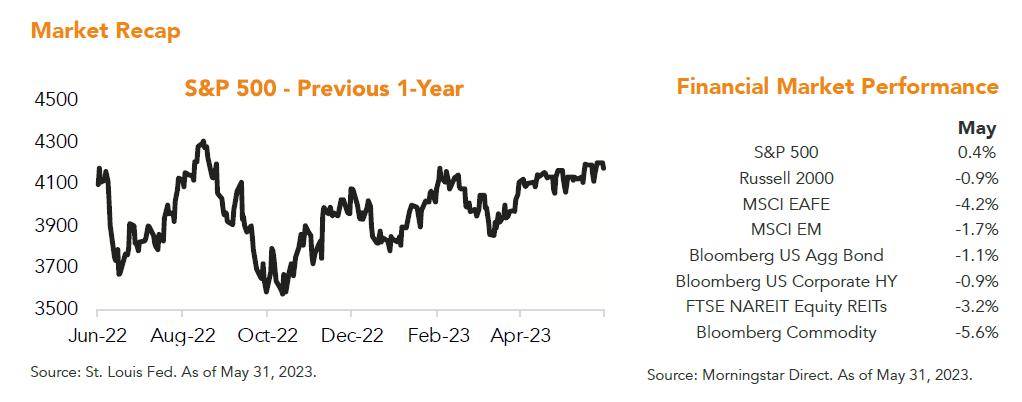
The stock market ended slightly higher in May, driven by the technology sector, which was up just under 10% for the month. Bonds declined as the odds increased slightly that the Federal Reserve may hike rates one more time in June. The S&P 500 is up 9.7% year to date, supported by better-than-expected data on the economy, and technology, which is up 34%. The Bloomberg U.S. Aggregate Bond Index fell 1.1% for the month while yields moved higher. Yields on the 2-year Treasury have risen, up 34 basis points since the start of the month from 4.02% to 4.36%. The 10-year Treasury yield rose from 3.43% to 3.60%, peaking at 3.82% on May 24. Small- and midcap stocks fell 0.9% and 2.8%, respectively. International markets ended the month with losses, underperforming the U.S. market as the U.S. dollar rose.
Q1 real gross domestic product was revised upward to 1.3% annualized, beating analyst expectations. Major drivers were a better-than-expected rise in consumer spending and declines in business investment and in inventories as companies continue to be weighed down by the Fed’s interest-rate hikes. Despite a decrease in business investment, consumer spending continues to surge as the consumer has benefited from low unemployment and steady wage gains. Given the strength of the consumer and the core Consumer Price Index continuing to stay higher longer than hoped, another Fed rate hike is possible in June but is far from certain. The next Fed meeting is June 14.
The U.S. Economy Remains Resilient
While Wall Street continues to warn of trouble ahead, the current picture of the economy is one of resilience. Q1 real GDP was revised up to a 1.3% annual rate from 1.1% in the advance estimate, which is a significant slowdown from the second half of 2022 but positive nonetheless. The coincident economic index, a monthly measure of economic activity, rose 1.7% in April, below the average 2.6% annual growth historically but, again, still positive. The S&P Global U.S. Composite PMI, a forward-looking indicator, climbed to 54.5 in May (figures above 50 indicate expansion), its highest level since April 2022. The latest improvement was all due to services, as manufacturing activity slipped back into contraction territory. This data indicates the economy is not currently in recession.
Consumer spending has been a key support for the economy, driven by strength in the labor market, excess savings from the pandemic and the availability of credit. Labor is the main source of income for consumers. With nonfarm payrolls still growing, the unemployment rate at a multi-decade low and wages still rising at an elevated pace, aggregate weekly payrolls have also held up well. Consumers have accumulated a significant amount of excess savings in large part due to massive government stimulus and government shutdowns during the pandemic. The San Francisco Fed recently estimated that there is still about $500 billion in excess savings, and the number could be even higher. While credit conditions have tightened in the aftermath of the banking crisis that unfolded in March and are a headwind to growth in the coming quarters, consumer credit has not dried up sufficiently enough to put the brakes on the economy— for now. Data for Q1 continued to show year-over-year growth for most types of loans, including credit cards and home equity lines of credit.
Of course, the cost of credit has increased rapidly and may slow the economy in time. Delinquency and default rates are still low by historical standards but are likely to increase. Historically, these rates have been an accurate forward-looking indicator of financial stress on the horizon.
Growth Stocks Surge
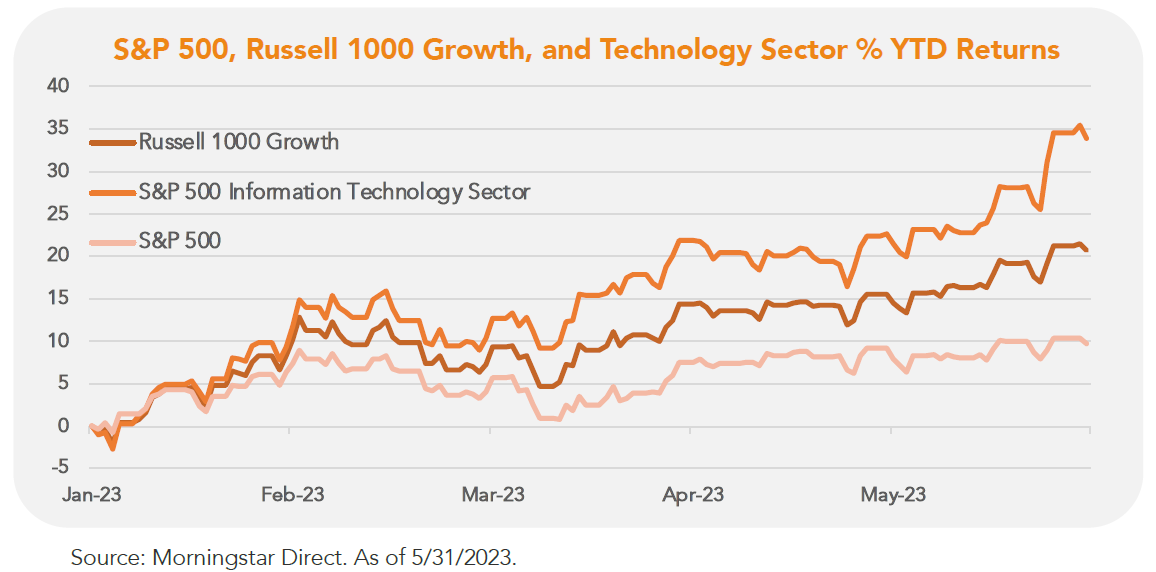
The Russell 1000 Growth Stock Index, which measures the performance of U.S. large-cap growth stocks, surged an additional 4.5% in May and is up 20.8% year to date. The Index was led by Nvidia Corp. as the stock soared 26% in a single day after the company’s raised sales forecast smashed expectations. The main drivers of Nvidia’s improved forecast were accelerated computing and generative AI, which has fueled enthusiasm for the entire technology sector. Tech stocks have been on a wild ride since the Fed began raising interest rates in March 2022, tumbling for most of last year and then rebounding for most of 2023. Tech bulls have been emboldened by the possibility that the Fed is close to ending its rate hikes, pushing S&P 500 tech stocks to their best first quarter since 1998.
Outlook
Diversification is a core investment principle and a critically important tool for managing risk. While it is tempting to add money to investments that are performing well and trim laggards, our advice instead is to build for balance. If your portfolio is properly diversified, chances are you will have investments that are disappointing in the short run. If all your investments are up at the same time, chances are your portfolio is not diversified properly. Remember, the mood on Wall Street can change very quickly. We believe chasing past performance is a surefire way of reducing investment returns. Instead, our advice is to stay focused, stay disciplined and stay confident that a diversified portfolio of high-quality investments is a better strategy than constantly trading your portfolio in an effort to boost returns.
¹Bloomberg
Disclosures:
This market commentary is meant for informational and educational purposes only and does not consider any individual personal considerations. As such, the information contained herein is not intended to be personal investment advice or recommendation. Please consult a financial professional before making any financial-related decisions.
The commentary represents an assessment of the market environment through May 2023. The views and opinions expressed may change based on the market or other conditions. The forward-looking statements are based on certain assumptions, but there can be no assurance that forward-looking statements will materialize. This commentary was written and provided by an unaffiliated third party.
Diversification is an investment strategy designed to help manage risk, but it cannot ensure a profit or protect against loss in a declining market.
Indexes are unmanaged and cannot be directly invested into. Past performance is no indication of future results. Investing involves risk and the potential to lose principal.
AdvicePeriod is another business name and brand utilized by both Mariner, LLC and Mariner Platform Solutions, LLC, each of which is an SEC registered investment adviser. Registration of an investment adviser does not imply a certain level of skill or training. Each firm is in compliance with the current notice filing requirements imposed upon SEC registered investment advisers by those states in which each firm maintains clients. Each firm may only transact business in those states in which it is notice filed or qualifies for an exemption or exclusion from notice filing requirements. Any subsequent, direct communication by an advisor with a prospective client shall be conducted by a representative that is either registered or qualifies for an exemption or exclusion from registration in the state where the prospective client resides. For additional information about Mariner, LLC or Mariner Platform Solutions, LLC, including fees and services, please contact us utilizing the contact information provided herein or refer to the Investment Adviser Public Disclosure website (www.adviserinfo.sec.gov). Please read the disclosure statement carefully before you invest or send money.
For additional information as to which entity your adviser is registered as an investment adviser representative, please refer to the Investment Adviser Public Disclosure website (www.adviserinfo.sec.gov) or the Form ADV 2B provided to you. Investment adviser representatives of Mariner, LLC dba Mariner Wealth Advisors and dba AdvicePeriod are generally employed by Mariner Wealth Advisors, LLC. Investment adviser representatives of Mariner Platform Solutions, LLC dba AdvicePeriod, are independent contractors.
Index Definitions: The S&P 500 is a capitalization-weighted index designed to measure the performance of the broad domestic economy through changes in the aggregate market value of 500 stocks representing all major industries. Russell 2000 consists of the 2,000 smallest U.S. companies in the Russell 3000 index. MSCI EAFE is an equity index which captures large and mid-cap representation across Developed Markets countries around the world, excluding the U.S. and Canada. The index covers approximately 85% of the free float-adjusted market capitalization in each country. MSCI Emerging Markets captures large and mid-cap representation across Emerging Markets countries. The index covers approximately 85% of the free-float adjusted market capitalization in each country. Bloomberg U.S. Aggregate Index covers the U.S. investment grade fixed rate bond market, with index components for government and corporate securities, mortgage pass-through securities, and asset-backed securities. Bloomberg U.S. Corporate High Yield Index covers the universe of fixed rate, non-investment grade debt. Eurobonds and debt issues from countries designated as emerging markets (sovereign rating of Baa1/BBB+/BBB+ and below using the middle of Moody’s, S&P, and Fitch) are excluded, but Canadian and global bonds (SEC registered) of issuers in non-EMG countries are included. FTSE NAREIT Equity REITs Index contains all Equity REITs not designed as Timber REITs or Infrastructure REITs. Bloomberg Commodity Index is calculated on an excess return basis and reflects commodity futures price movements. The index rebalances annually weighted 2/3 by trading volume, and 1/3 by world production and weight-caps are applied at the commodity, sector, and group level for diversification.
Does past performance matter?
Major Market Index Returns
Period Ending 6/1/2023
Multi-year returns are annualized.
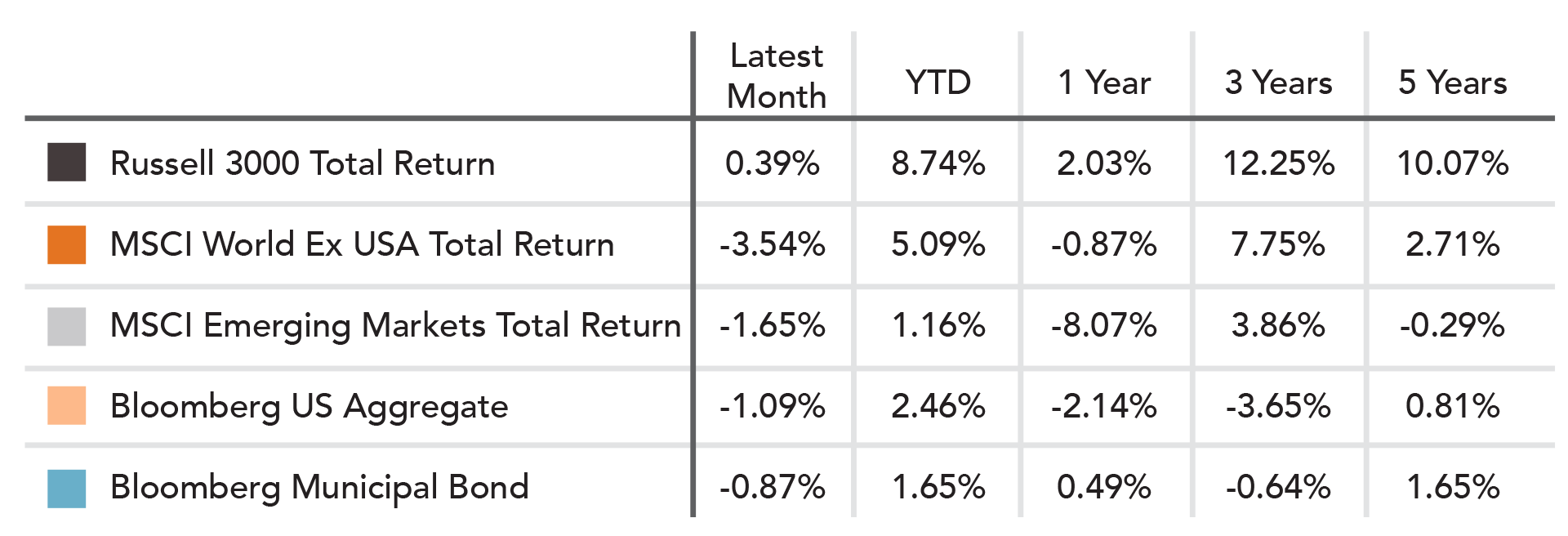
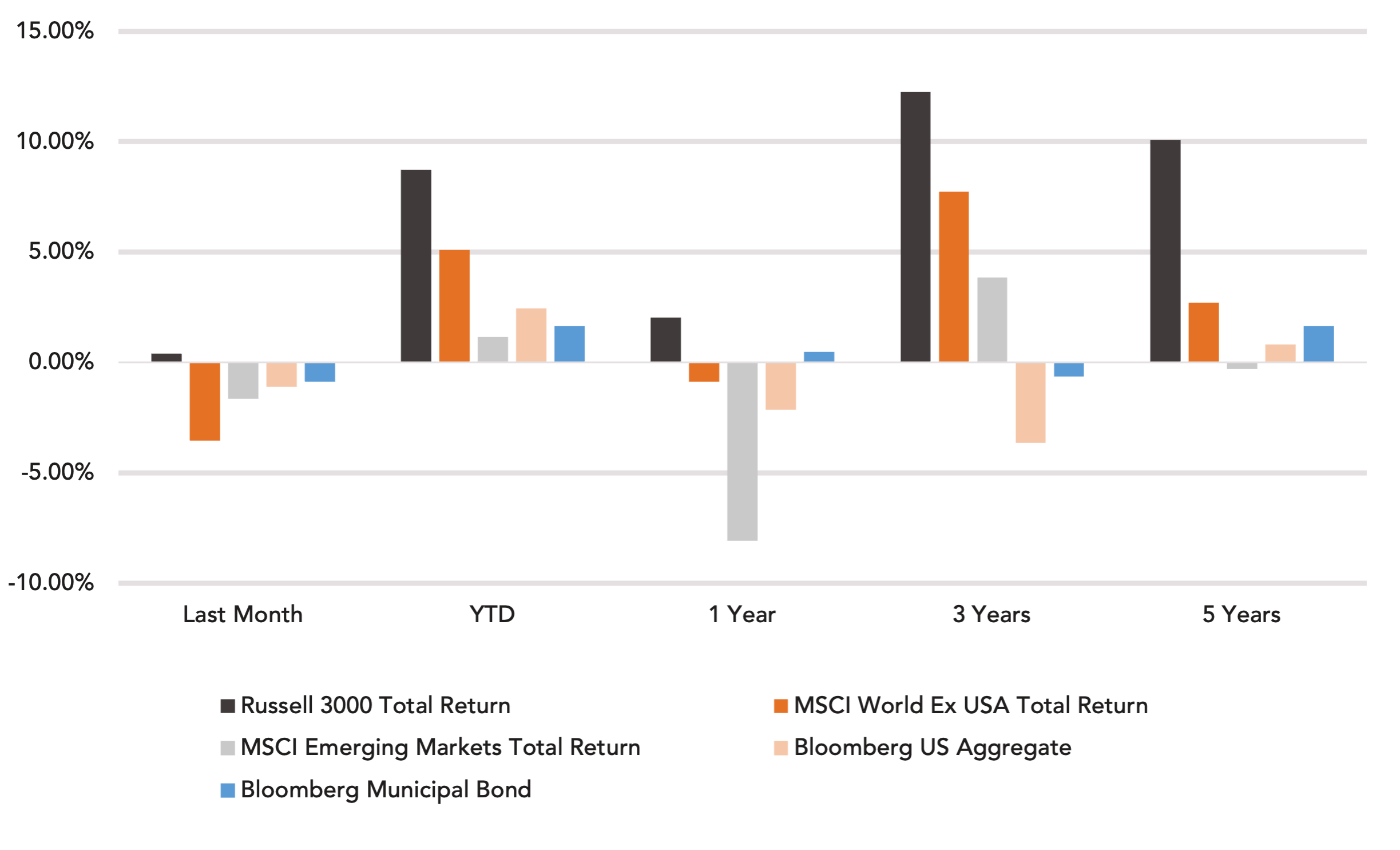
Mix Index Returns
Global Equity / US Taxable Bonds
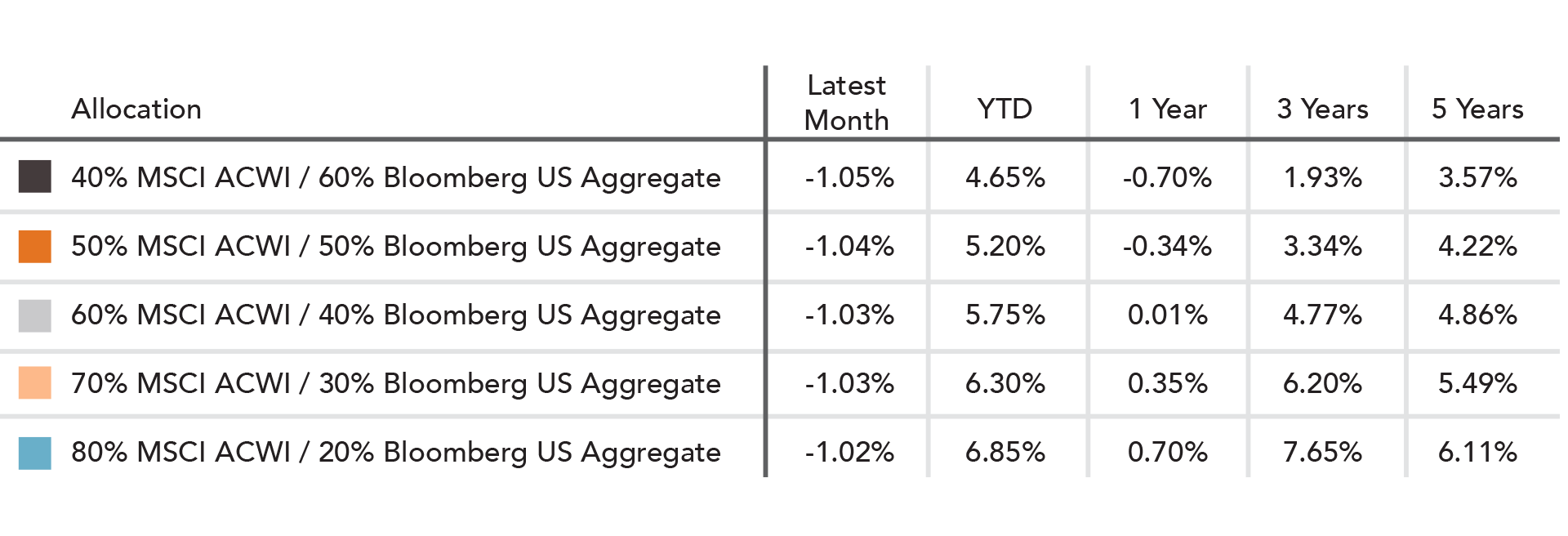
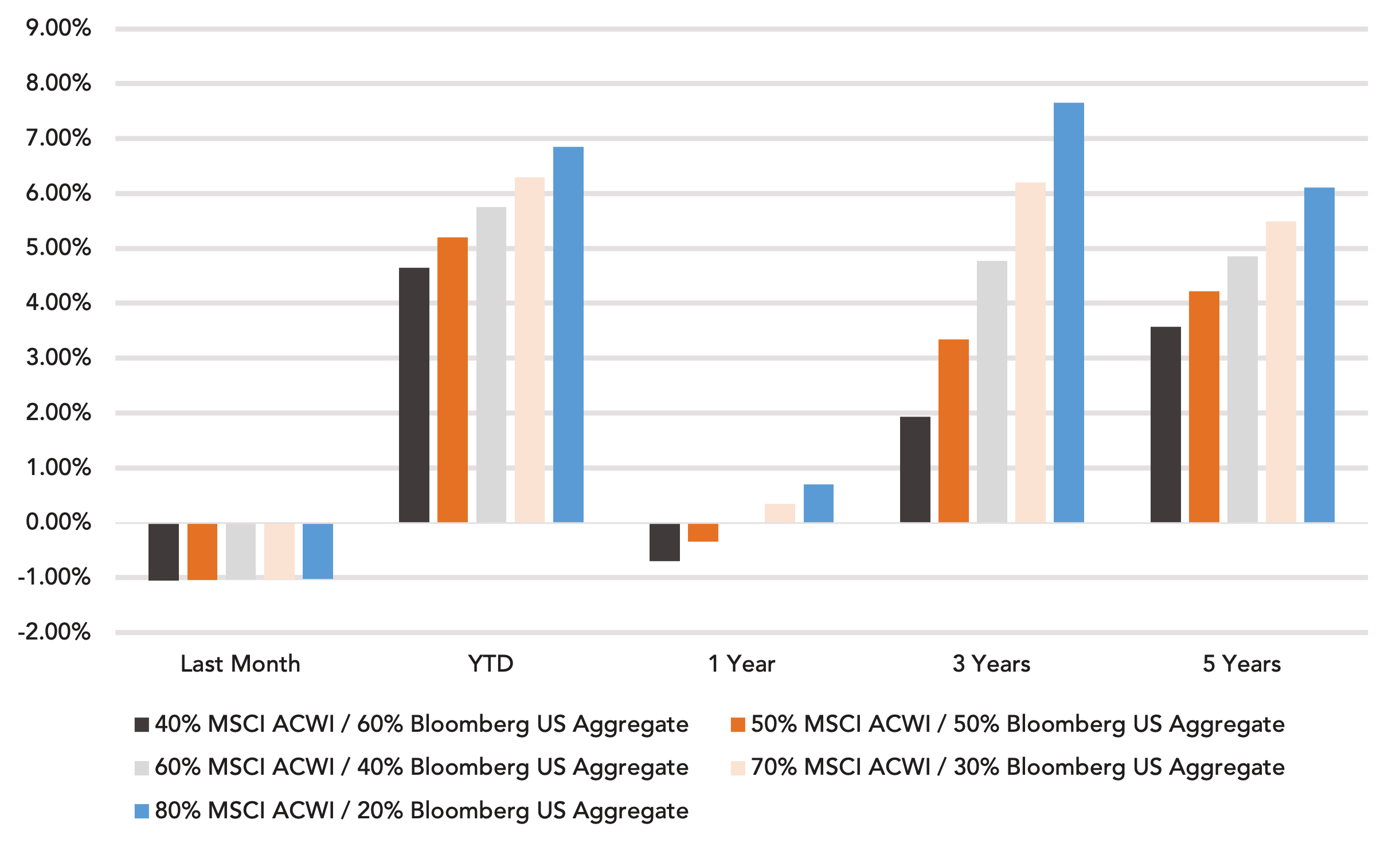
Indexes are unmanaged and cannot be directly invested into. Past performance is no indication of future results. Investing involves risk and the potential to lose principal.
The Russell 3000 Index is a United States market index that tracks the 3000 largest companies. MSCI Emerging Markets Index is a broad market cap-weighted Index showing the performance of equities across 23 emerging market countries defined as emerging markets by MSCI. MSCI ACWI ex-U.S. Index is a free-float adjusted market capitalization-weighted index that is designed to measure the equity market performance of developed and emerging markets excluding companies based in the United States. Bloomberg U.S. Aggregate Bond Index represents the investment-grade, U.S. dollar-denominated, fixed-rate taxable bond market, including Treasuries, government-related and corporate securities, as well as mortgage and asset-backed securities. Bloomberg Municipal Index is the US Municipal Index that covers the US dollar-denominated long-term tax-exempt bond market. The index has four main sectors: state and local general obligation bonds, revenue bonds, insured bonds, and prerefunded bonds.

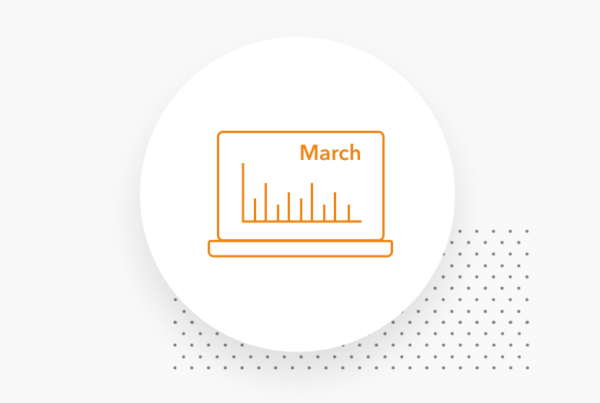


April 2024 Market Commentary